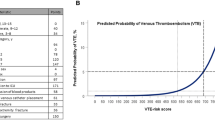Abstract
Purpose
New guidelines have been proposed for venous thromboembolism (VTE) prophylaxis in pediatric trauma patients. This paper seeks to evaluate risk factors associated with VTE that might further guide patient selection for prophylaxis.
Methods
Review of a tertiary children’s academic hospital’s trauma database for VTE events and associated risk factors from 2005 to 2016.
Results
15,306 pediatric trauma patients were identified and reviewed. During this time period there were 6191 admissions (40.4%), of which 20 developed a VTE (0.3%) including two pulmonary emboli. Primary outcome was comparison of risk factors for developing a VTE that were identified in the literature. Age stratification revealed the highest incidence of VTE in children under the age of 2 (0.7%), which increased with CVC placement when compared to children aged 2–12 and 13–15 (0.036 Fisher’s exact test).
Conclusions
VTE after pediatric trauma is rare, and may be more uncommon than previously reported. CVC placement was the strongest predictor of VTE, particularly in infant and toddler patients which can explain their higher overall incidence compared to other pediatric age groups. Identifying high-risk patients is important to optimize screening and prophylaxis of VTE in pediatric trauma patients while minimizing risks of anticoagulation.

Similar content being viewed by others
References
Raffini L, Huang YS, Witmer C, Feudtner C (2009) Dramatic increase in venous thromboembolism in children’s hospitals in the United States from 2001 to 2007. Pediatrics 124(4):1001–1008
Andrew M, David M, Adams M, Ali K, Anderson R, Barnard D et al (1994) Venous thromboembolic complications (VTE) in children: first analyses of the Canadian registry of VTE. Blood 83(5):1251–1257
Takemoto CM, Sohi S, Desai K, Bharaj R, Khanna A, McFarland S et al (2014) Hospital-associated venous thromboembolism in children: incidence and clinical characteristics. J Pediatr 164(2):332–338
van Ommen CH, Heijboer H, Buller HR, Hirasing RA, Heijmans HS, Peters M (2001) Venous thromboembolism in childhood: a prospective two-year registry in The Netherlands. J Pediatr 139(5):676–681
Kerlin BA (2012) Current and future management of pediatric venous thromboembolism. Am J Hematol 87(Suppl 1):S68–S74
Goudie A, Dynan L, Brady PW, Fieldston E, Brilli RJ, Walsh KE (2015) Costs of venous thromboembolism, catheter-associated urinary tract infection, and pressure ulcer. Pediatrics 136(3):432–439
Malec L, Young G (2017) treatment of venous thromboembolism in pediatric patients. Front Pediatr 5:26
Van Arendonk KJ, Schneider EB, Haider AH, Colombani PM, Stewart FD, Haut ER (2013) Venous thromboembolism after trauma: when do children become adults? JAMA Surg 148(12):1123–1130
Allen CJ, Murray CR, Meizoso JP, Ray JJ, Neville HL, Schulman CI et al (2016) Risk factors for venous thromboembolism after pediatric trauma. J Pediatr Surg 51(1):168–171
Yen J, Van Arendonk KJ, Streiff MB, McNamara L, Stewart FD, Conner KG et al (2016) Risk factors for venous thromboembolism in pediatric trauma patients and validation of a novel scoring system: the risk of clots in kids with trauma score. Pediatr Crit Care Med 17(5):391–399
Vavilala MS, Nathens AB, Jurkovich GJ, Mackenzie E, Rivara FP (2002) Risk factors for venous thromboembolism in pediatric trauma. J Trauma 52(5):922–927
Hanson SJ, Punzalan RC, Arca MJ, Simpson P, Christensen MA, Hanson SK et al (2012) Effectiveness of clinical guidelines for deep vein thrombosis prophylaxis in reducing the incidence of venous thromboembolism in critically ill children after trauma. J Trauma Acute Care Surg 72(5):1292–1297
Mahajerin A, Petty JK, Hanson SJ, Thompson AJ, O’Brien SH, Streck CJ et al (2017) Prophylaxis against venous thromboembolism in pediatric trauma: a practice management guideline from the eastern association for the surgery of trauma and the pediatric trauma society. J Trauma Acute Care Surg 82(3):627–636
Geerts W (2014) Central venous catheter-related thrombosis. Hematol Am Soc Hematol Educ Program 2014(1):306–311
Acknowledgements
Jeffrey Tomasek and the Center for Translational Research (CeTIR) for their assistance in compiling and maintaining this database that this study was based on.
Funding
No funding was provided for this study.
Author information
Authors and Affiliations
Corresponding author
Ethics declarations
Conflict of interest
All authors declare that they have no conflict of interest.
Ethical approval
All procedures performed in studies involving human participants were in accordance with the ethical standards of the institutional and/or national research committee and with the 1964 Helsinki declaration and its later amendments or comparable ethical standards.
Informed consent
Informed consent was waived after review by IRB due to retrospective, anonymous and minimal risk nature of this study.
Rights and permissions
About this article
Cite this article
Carrillo, L.A., Kumar, A., Harting, M.T. et al. Venous thromboembolism risk factors in a pediatric trauma population. Pediatr Surg Int 35, 487–493 (2019). https://doi.org/10.1007/s00383-018-4418-y
Accepted:
Published:
Issue Date:
DOI: https://doi.org/10.1007/s00383-018-4418-y




